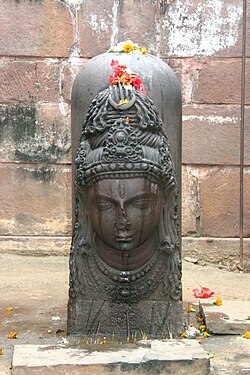பூமரா கோயில்
| பூமரா கோயில் பர்குலீஸ்வரர் கோயில் | |
|---|---|
 கிபி 5 அல்லது 6-ஆம் நூற்றாண்டின் சிவனுக்குரிய கற்கோயில் | |
| அடிப்படைத் தகவல்கள் | |
| அமைவிடம் | பூம்ரா, நகோட் |
| புவியியல் ஆள்கூறுகள் | 24°25′42.1″N 80°38′29.6″E / 24.428361°N 80.641556°E |
| சமயம் | இந்து சமயம் |
| மாநிலம் | மத்தியபிரதேசம் |
| மாவட்டம் | சத்னா[1] |
பூமரா கோயில் அல்லது பர்குலீஸ்வரர் கோயில் (இக்கோயிலை பூமரா கோயில், பூப்பரா கோயில், பூம்ரா கோயில் என்றும் அழைப்பர்) (Bhumara Temple, sometimes called Bhumra or Bhubhara), இது கிபி 5 அல்லது 6-ஆம் நூற்றாண்டின் குப்தர்கள் காலத்து இந்து கற்கோயில் ஆகும். சிவபெருமானுக்கு அர்ப்பணிக்கபப்ட்ட இக்கோயில் மத்தியப் பிரதேசத்தின் சத்னா மாவட்டத்தின் நிர்வாகத் தலைமையிடமான சத்னா நகரத்திற்கு தென்மேற்கில் 40 கிமீ தொலைவில் உள்ளது.[2][3][4]சதுர வடிவில் அமைந்த இக்கோயில் ஒரு மண்டபத்துடன் கூடியது.[5]தற்போது இக்கோயிலின் பெரும்பகுதிகள் சிதிலமடைந்து உள்ளது. இக்கோயில் சுற்றுப் பிரகாரங்களைக் கொண்டது. இக்கோயிலின் கருவறையின் நுழைவாயிலில் கங்கை மற்றும் யமுனா தேவிகளின் சிற்பங்கள் கொண்டுள்ளது.[1][6] இக்கோயில் கருவறையின் ஒருமுக சிவலிங்கம் குப்தர்களின் கலைநயத்திற்கு எடுத்துக்காட்டாகும்.
இக்கோயிலில் மகிஷாசூரனை கொன்ற துர்கை மற்றும் விநாயகர், முருகன், விஷ்ணு, பிரம்மா, யமன், குபேரன், சூரியன், ���ன்மதன் போன்ற தேவர்களின் சிற்பங்கள் உள்ளது.[7][5][8]

காலம்
[தொகு]1920-இல் அகழாய்வில் கண்டெடுக்கப்பட்ட குப்தர் காலத்து இக்கோயிலின் காலம், கிபி 5-6-ஆம் நூற்றாண்டு காலத்தவை என தொல்லியல் அறிஞர்கள் கணக்கிட்டுள்ளனர்.[9][10][5][11]


இதனையும் காண்க
[தொகு]மேற்கோள்கள்
[தொகு]- ↑ 1.0 1.1 "Bhumra temple". Archaeological Survey of India, Bhopal Circle.
- ↑ George Michell 1988, ப. 39, 95.
- ↑ Heather Elgood (2000). Hinduism and the Religious Arts. Bloomsbury Publishing. p. 144. பன்னாட்டுத் தரப்புத்தக எண் 978-0-8264-9865-6., Quote: "Other examples are the fifth-century Siva temple at Bhumara which has a fine ekamukha (single faced) linga, a sixth century Dasavatara temple at Deogarh (...)".
- ↑ Bhumra (Bhumara) Shiva temple, viewed from south, Gupta Dynasty, India, ca. 5th-6th century A.D. C. Krishna Gairola (1975), University of Washington
- ↑ 5.0 5.1 5.2 Ulrich Wiesner (1978). Nepalese Temple Architecture: Its Characteristics and Its Relations to Indian Development. BRILL Academic. pp. 46–48. பன்னாட்டுத் தரப்புத்தக எண் 90-04-05666-1.
- ↑ Ulrich Wiesner (1978). Nepalese Temple Architecture: Its Characteristics and Its Relations to Indian Development. BRILL Academic. pp. 46–48, 74. பன்னாட்டுத் தரப்புத்தக எண் 90-04-05666-1.
- ↑ Radhakumud Mookerji (1959). The Gupta Empire. Motilal Banarsidass. p. 146. பன்னாட்டுத் தரப்புத்தக எண் 978-81-208-0440-1.
- ↑ Banerji 1998, ப. 9-10, with Plates XII-XV.
- ↑ Heather Elgood (2000). Hinduism and the Religious Arts. Bloomsbury Publishing. p. 144. பன்னாட்டுத் தரப்புத்தக எண் 978-0-8264-9865-6.
- ↑ Frederick M. Asher (1980). The Art of Eastern India: 300 - 800. University of Minnesota Press. p. 27. பன்னாட்டுத் தரப்புத்தக எண் 978-1-4529-1225-7.
- ↑ Michael W. Meister (1984). Discourses on Siva. University of Pennsylvania Press. p. 494. பன்னாட்டுத் தரப்புத்தக எண் 978-0-8122-7909-2.
ஆதார நூற்பட்டியல்
[தொகு]- Prasanna Kumar Acharya (2010). An encyclopaedia of Hindu architecture. Oxford University Press (Republished by Motilal Banarsidass). பன்னாட்டுத் தரப்புத்தக எண் 978-81-7536-534-6.
- Prasanna Kumar Acharya (1997). A Dictionary of Hindu Architecture: Treating of Sanskrit Architectural Terms with Illustrative Quotations. Oxford University Press (Reprinted in 1997 by Motilal Banarsidass). பன்னாட்டுத் தரப்புத்தக எண் 978-81-7536-113-3.
- Vinayak Bharne; Krupali Krusche (2014). Rediscovering the Hindu Temple: The Sacred Architecture and Urbanism of India. Cambridge Scholars Publishing. பன்னாட்டுத் தரப்புத்தக எண் 978-1-4438-6734-4.
- Alice Boner (1990). Principles of Composition in Hindu Sculpture: Cave Temple Period. Motilal Banarsidass. பன்னாட்டுத் தரப்புத்தக எண் 978-81-208-0705-1.
- Alice Boner; Sadāśiva Rath Śarmā (2005). Silpa Prakasa. Brill Academic (Reprinted by Motilal Banarsidass). பன்னாட்டுத் தரப்புத்தக எண் 978-8120820524.
- A.K. Coomaraswamy; Michael W. Meister (1995). Essays in Architectural Theory. Indira Gandhi National Centre for the Arts. பன்னாட்டுத் தரப்புத்தக எண் 978-0-19-563805-9.
- Dehejia, V. (1997). Indian Art. Phaidon: London. பன்னாட்டுத் தரப்புத்தக எண் 0-7148-3496-3.
- Adam Hardy (1995). Indian Temple Architecture: Form and Transformation. Abhinav Publications. பன்னாட்டுத் தரப்புத்தக எண் 978-81-7017-312-0.
- Adam Hardy (2007). The Temple Architecture of India. Wiley. பன்னாட்டுத் தரப்புத்தக எண் 978-0470028278.
- Adam Hardy (2015). Theory and Practice of Temple Architecture in Medieval India: Bhoja's Samarāṅgaṇasūtradhāra and the Bhojpur Line Drawings. Indira Gandhi National Centre for the Arts. பன்னாட்டுத் தரப்புத்தக எண் 978-93-81406-41-0.
- Harle, J.C., The Art and Architecture of the Indian Subcontinent, 2nd edn. 1994, Yale University Press Pelican History of Art, பன்னாட்டுத் தரப்புத்தக எண் 0300062176
- Monica Juneja (2001). Architecture in Medieval India: Forms, Contexts, Histories. Orient Blackswan. பன்னாட்டுத் தரப்புத்தக எண் 978-8178242286.
- Stella Kramrisch (1976). The Hindu Temple Volume 1. Motilal Banarsidass (Reprinted 1946 Princeton University Press). பன்னாட்டுத் தரப்புத்தக எண் 978-81-208-0223-0.
- Stella Kramrisch (1979). The Hindu Temple Volume 2. Motilal Banarsidass (Reprinted 1946 Princeton University Press). பன்னாட்டுத் தரப்புத்தக எண் 978-81-208-0224-7.
- Michael W. Meister; Madhusudan Dhaky (1986). Encyclopaedia of Indian temple architecture. American Institute of Indian Studies. பன்னாட்டுத் தரப்புத்தக எண் 978-0-8122-7992-4.
- George Michell (1988), The Hindu Temple: An Introduction to Its Meaning and Forms, University of Chicago Press, பன்னாட்டுத் தரப்புத்தக எண் 978-0-226-53230-1
- George Michell (2000). Hindu Art and Architecture. Thames & Hudson. பன்னாட்டுத் தரப்புத்தக எண் 978-0-500-20337-8.
- T. A. Gopinatha Rao (1993). Elements of Hindu iconography. Motilal Banarsidass. பன்னாட்டுத் தரப்புத்தக எண் 978-81-208-0878-2.
- Ajay J. Sinha (2000). Imagining Architects: Creativity in the Religious Monuments of India. University of Delaware Press. பன்னாட்டுத் தரப்புத்தக எண் 978-0-87413-684-5.
- Burton Stein (1978). South Indian Temples. Vikas. பன்னாட்டுத் தரப்புத்தக எண் 978-0706904499.
- Burton Stein (1989). The New Cambridge History of India: Vijayanagara. Cambridge University Press. பன்னாட்டுத் தரப்புத்தக எண் 978-0-521-26693-2.
- Burton Stein; David Arnold (2010). A History of India. John Wiley & Sons. பன்னாட்டுத் தரப்புத்தக எண் 978-1-4443-2351-1.
- Kapila Vatsyayan (1997). The Square and the Circle of the Indian Arts. Abhinav Publications. பன்னாட்டுத் தரப்புத்தக எண் 978-81-7017-362-5.
- Banerji, R. D. (1998), The Temple of Siva at Bhumara, Memoirs of the Archaeological Survey of India No 16 (Orig year 1924),
 இந்தக் கட்டுரை பொது உரிமையில் உள்ள மூலத்திலிருந்து உரையைக் கொண்டுள்ளது.
இந்தக் கட்டுரை பொது உரிமையில் உள்ள மூலத்திலிருந்து உரையைக் கொண்டுள்ளது. - ASI (1920), Progress Report of the ASI Western Circle 1920, Archaeological Survey of India,
 இந்தக் கட்டுரை பொது உரிமையில் உள்ள மூலத்திலிருந்து உரையைக் கொண்டுள்ளது.
இந்தக் கட்டுரை பொது உரிமையில் உள்ள மூலத்திலிருந்து உரையைக் கொண்டுள்ளது. - Michael W. Meister u. a. (Eds.): Encyclopaedia of Indian Temple Architecture. North India - Foundations of North Indian Style Princeton University Press, Princeton, 1988, பன்னாட்டுத் தரப்புத்தக எண் 0-691-04053-2, p 40ff.
வெளி இணப்புகள்
[தொகு] பொதுவகத்தில் Bhumara Temple தொடர்பாக ஊடகக் கோப்புகள் உள்ளன.
பொதுவகத்தில் Bhumara Temple தொடர்பாக ஊடகக் கோப்புகள் உள்ளன.

